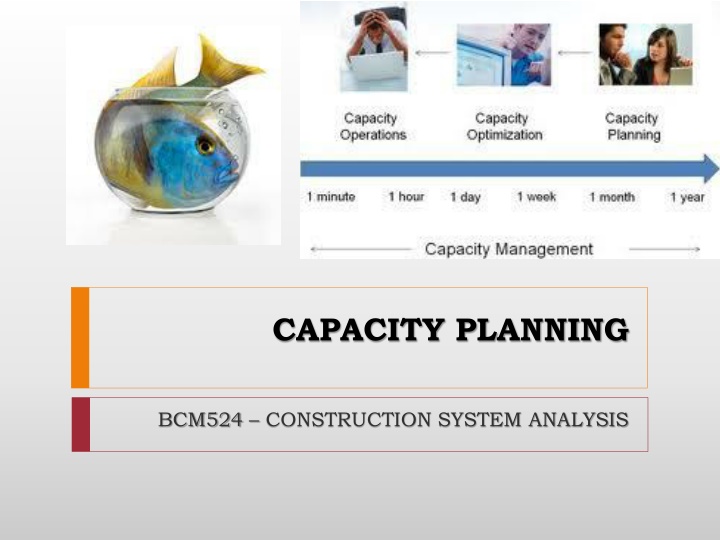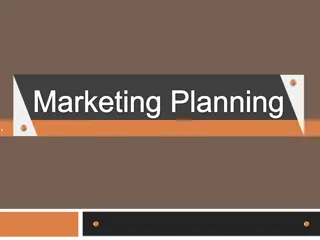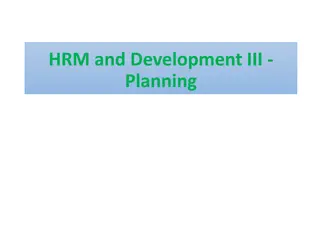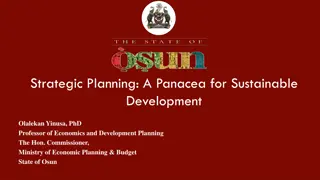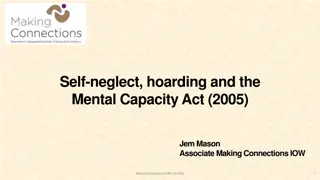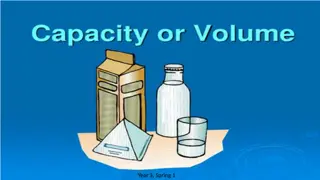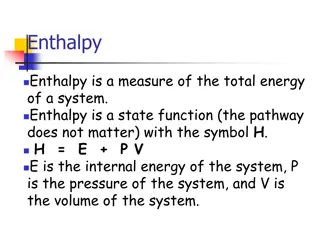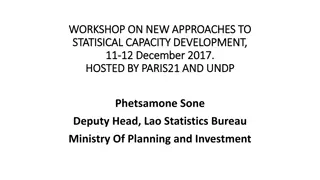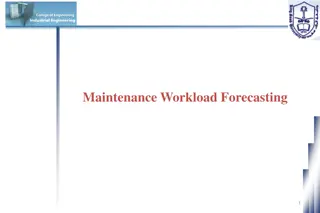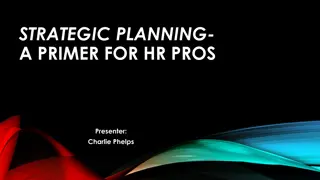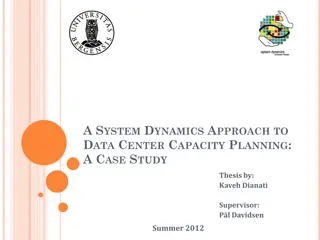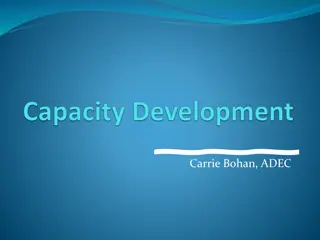Capacity Planning and Strategic Decisions
Capacity planning is crucial for managing resources efficiently, determining future needs, and ensuring competitiveness. Strategic decisions in capacity management impact operating costs, long-term commitments, and overall business success. Understand the importance of capacity decisions, effective capacity design, and utilization metrics to optimize operational performance.
Download Presentation

Please find below an Image/Link to download the presentation.
The content on the website is provided AS IS for your information and personal use only. It may not be sold, licensed, or shared on other websites without obtaining consent from the author.If you encounter any issues during the download, it is possible that the publisher has removed the file from their server.
You are allowed to download the files provided on this website for personal or commercial use, subject to the condition that they are used lawfully. All files are the property of their respective owners.
The content on the website is provided AS IS for your information and personal use only. It may not be sold, licensed, or shared on other websites without obtaining consent from the author.
E N D
Presentation Transcript
CAPACITY PLANNING BCM524 CONSTRUCTION SYSTEM ANALYSIS
Capacity Planning Capacity is the ability to hold, receive, store or accommodate raw materials, finished products, customers, etc. Capacity is the upper limit or ceiling on the load that an operating unit can handle. Capacity refers to a system s potential for producing goods or delivering services over a specified time interval The basic questions in capacity handling are: What kind of capacity is needed? How much is needed? When is it needed? 2 2/24/2025
Strategic Capacity Planning Strategic Capacity Planning is an approach for determining the overall capacity level of capital intensive resources, including facilities, equipment and overall labour force size. Capacity used is the rate of output actually achieved The best operating level is nominally the capacity of which the process was designed 3 2/24/2025
Process Selection and System Design Facilities and Equipment Capacity Planning Forecasting Product and Service Design Layout Process Selection Work Design Technological Change 4 2/24/2025
Importance of Capacity Decisions 1. Impacts ability to meet future demands 2. Affects operating costs 3. Major determinant of initial costs 4. Involves long-term commitment 5. Affects competitiveness 6. Affects ease of management 7. Globalization adds complexity 8. Impacts long range planning 5 Ani Maslina Saleh / BCM542 / AP246 2/24/2025
Capacity Decisions Design capacity Maximum capability to produce: Rated capacity is theoretical Effective capacity includes efficiency and utilization maximum output rate or service capacity an operation, process, or facility is designed for Effective capacity Design capacity minus allowances such as personal time, maintenance, and scrap Actual output rate of output actually achieved--cannot exceed effective capacity. a. b. 6 2/24/2025
What is capacity? Capacity Utilization Percent of available time spent working Capacity Efficiency How well a machine or worker performs compared to a standard output level Capacity Load Standard hours of work assigned to a facility Capacity Load Percent Ratio of load to capacity 7 2/24/2025
Capacity Requirement Dimension of Demand Quantity Effect on capacity requirement How much capacity is needed? Timing When should capacity be available? What kind of capacity is needed? Where should capacity be installed? Quality Location 8 2/24/2025
Capacity Planning Capacity is the maximum output rate of a production or service facility Capacity planning is the process of establishing the output rate that may be needed at a facility : Capacity is usually purchased in chunks Strategic issues : how much and when to spend capital additional facility & equipment Tactical issues : workforce & inventory levels, and day-to-day use of equipment 9 2/24/2025
Measuring Capacity Examples There is no one best way to measure capacity Output measures like cars per day are easier to understand While multiple products, inputs measures work better Type of Business Input measures of capacity Output measures of capacity Car Manufacturer Labour Hours Cars per shift Hospital Available Beds Patients per month Pizza Parlor Labour Hours Pizzas per day Floor Space in ft Revenue per ft Retail Store 10 2/24/2025
Efficiency and Utilization Actual output Capacity Efficiency = Effective capacity Capacity Utilization = Actual output Design capacity Both measures expressed as percentages 11 Ani Maslina Saleh / BCM542 / AP246 2/24/2025
Efficiency/Utilization Example Design capacity = 50 trucks/day Effective capacity = 40 trucks/day Actual output = 36 units/day Actual output = 36 units/day Effective capacity 40 units/ day Efficiency = Utilization = = 90% Actual output = 36 units/day Design capacity 50 units/day = 72% 12 Ani Maslina Saleh / BCM542 / AP236 2/24/2025
Determinants of Effective Capacity Facilities Product and service factors Process factors Human factors Operational factors Supply chain factors External factors 13 Ani Maslina Saleh / BCM542 / AP236 2/24/2025
Table Factors that determine effective capacity Facilities Design Location Layout Environment Product / Service Design Product or service mix Process Quantities capabilities Quality Capabilities Human factors Job content Job design Training and experience Motivation Compensation Learning rates Absenteeism and labor turnover Operational Scheduling Materials management Quality assurance Maintenance policies Equipment breakdowns External factors Product standards Safety regulations Unions Pollution control standards 14 Ani Maslina Saleh / BCM542 / AP236 2/24/2025
Strategy Formulation Capacity strategy for long-term demand Demand patterns Growth rate and variability Facilities Cost of building and operating Technological changes Rate and direction of technology changes Behavior of competitors Availability of capital and other inputs 15 Ani Maslina Saleh / BCM542 / AP236 2/24/2025
Key Decisions of Capacity Planning 1. Amount of capacity needed Involves consideration of expected demand and capacity costs. The greater demand of uncertainty, the greater amount of capacity cushion 2. Timing of changes Relates to availability of capital, lead time needed to make changes and expected demand 3. Need to maintain balance Requires proportionate changes in capacity in all related areas of the system 4. Extent of flexibility of facilities Influence by the uncertainty about demand and the degree of variety in work requirements. Capacity cushion extra demand intended to offset uncertainty 16 2/24/2025
Steps for Capacity Planning 1. Estimate future capacity requirements 2. Evaluate existing capacity 3. Identify alternatives 4. Conduct financial analysis 5. Assess key qualitative issues 6. Select one alternative 7. Implement alternative chosen 8. Monitor results 17 Ani Maslina Saleh / BCM542 / AP236 2/24/2025
Calculating Processing Requirements A department works one eight-hour shift, 250 days a year. And has these figures for usage of a machine that is being considered: Standard processing time per unit (hr.) Annual Demand Processing time needed (hr.) Product #1 400 5.0 2,000 #2 300 8.0 2,400 #3 700 2.0 1,400 5,800 Annual capacity - 8 hours shift and 250 working days a year to produce 3 products need how many machine? 5,800 hours = 2.9 machines (equiv. To 3 machines) 2,000 hours/machine
Make or Buy Once capacity requirements have been determined, the organisation must decide whether to produce a good or provide a service itself, or to outsource (buy) from other organisation. Reason to make or buy as those factors : 1. Available capacity 2. Expertise 3. Quality considerations 4. Nature of demand 5. Cost 6. Risk 19 Ani Maslina Saleh / BCM542 / AP236 2/24/2025
Developing Capacity Alternatives 1. Design flexibility into systems 2. Take stage of life cycle into account 3. Take a big picture approach to capacity changes 4. Prepare to deal with capacity chunks 5. Attempt to smooth out capacity requirements 6. Identify the optimal operating level 20 Ani Maslina Saleh / BCM542 / AP236 2/24/2025
Economies of Scale Economies of scale If the output rate is less than the optimal level, increasing output rate results in decreasing average unit costs Diseconomies of scale If the output rate is more than the optimal level, increasing the output rate results in increasing average unit costs 21 Ani Maslina Saleh / BCM542 / AP236 2/24/2025
Evaluating Alternatives Production units have an optimal rate of output for minimal cost. Average cost per unit Minimum average cost per unit Under- Utilization Over- Utilization Minimum cost Best Operating Level 0 Rate of output 22 2/24/2025
Evaluating Alternatives Minimum cost & optimal operating rate are functions of size of production unit. Average cost per unit Small plant Medium plant Large plant 0 Output rate 23 Ani Maslina Saleh / BCM542 / AP236 2/24/2025
Planning Service Capacity Need to be near customers Capacity and location are closely tied Inability to store services Capacity must be matched with timing of demand Degree of volatility of demand Peak demand periods 24 Ani Maslina Saleh / BCM542 / AP236 2/24/2025
Evaluating Alternatives A number of techniques are useful for evaluating capacity alternatives from an economic standpoint. Some of the more common are cost-volume analysis, financial analysis, decision theory and waiting-line analysis, 25 Ani Maslina Saleh / BCM542 / AP236 2/24/2025
Cost-Volume Analysis Cost-volume analysis focuses on relationship between cost, revenue and volume of out-put. The purpose of cost-volume analysis is to estimate the income of an organisation under different operating conditions. As a tool for comparing capacity alternatives Fixed costs remain constant regardless of volume of output (e.g. Rental costs, property taxes, equipment costs, heating and cooling expenses and administrative costs) 26 Ani Maslina Saleh / BCM542 / AP236 2/24/2025
Cost-Volume Analysis Variable costs variable costs per unit remains the same regardless of volume of output and all the output can be sold (e.g. Materials and labour costs) Total costs volume of output is equal to the sum of the fixed cost and the variable cost per unit times volume: TC = FC + VC VC = Q x v TR = R X Q FC = Fixed cost VC = Total variable cost TC = Total cost TR = Total revenue R = Revenue per unit v = Variable cost per unit Q = Quantity or volume of output 27 Ani Maslina Saleh / BCM542 / AP236 2/24/2025
Cost-Volume Relationships Figure 5.5a Amount ($) VC = Q x v Fixed cost (FC) 0 Q (volume in units) A. Fixed, variable and total costs 28 Ani Maslina Saleh / BCM542 / AP236 2/24/2025
Cost-Volume Relationships Amount TR = R X Q ($) 0 Q (volume in units) B. Total revenue increases linearly with ouput 29 Ani Maslina Saleh / BCM542 / AP236 2/24/2025
Cost-Volume Relationships Profit (P) = TR TC Or Amount ($) P = Q (R v) - FC FC QBEP = R - v 0Break Even Point (BEP) units Q (volume in units) 30 Ani Maslina Saleh / BCM542 / AP236 2/24/2025
Assumptions of Cost-Volume Analysis 1. One product is involved 2. Everything produced can be sold 3. Variable cost per unit is the same regardless of volume 4. Fixed costs do not change with volume 5. Revenue per unit constant with volume 6. Revenue per unit exceeds variable cost per unit 31 Ani Maslina Saleh / BCM542 / AP236 2/24/2025
Example 2 Cost-Volume Analysis The owner Old-Fashioned Berry Pie, S.Simon, is contemplating adding a new line of pies, which will require leasing new equipment for a monthly payment of $6,000. Variable costs would be $2.00 per pie, and pies would retail for $7.00 each How many pies must be sold in order to break even? What would the profit (loss) be if 1,000 pies are made and sold in a month? How many pies must be sold to realize a profit of $4,000? If 2,000 can be sold, and profit target is $5,000, what price should be charged per pie? a) b) c) d) 32 Ani Maslina Saleh / BCM542 / AP236 2/24/2025
Example 2 - Solution FC = $ 6,000, VC = $2 per pie, Rev = $7 per pie FC $6,000 a. QBEP = = = 1,200 pies/month Rev VC $7 - $2 b. For Q = 1,000, P = Q (R - v) FC = 1,000($7 - $2) - $6,000 = -$1,000 (loss) 33 Ani Maslina Saleh / BCM542 / AP236 2/24/2025
Example 2 - Solution c. P = $4,000 using the following formula P + FC $4,000 + $6,000 Q = = = 2,000 pies R - v $7 - $2 d. Profit = Q (R - v) - FC $5,000 = 2,000 (R - $2) - $6,000 R = $ 7.50 34 Ani Maslina Saleh / BCM542 / AP236 2/24/2025
Example 3 Cost-Volume Analysis A manager has the opinion of purchasing one, two or three machines. Fixed costs and potential volumes are as follows : Number of Machines 1 2 3 Total Annual Fixed Costs $9,600 $15,000 $20,000 Corresponding Range of Output 0 to 300 301 to 600 601 - 900 Variable cost is $10 per unit, and revenue is $40 per unit. a. Determine the break-even point for each range. b. If projected annual demand is between 580 and 660 units, how many machines should the manager purchase? 35 Ani Maslina Saleh / BCM542 / AP236 2/24/2025
Example 3 - Solution a. Compute the break-even point for each range using the formula FC QBEP = R - v For 1 machine : $9,600 QBEP = = 320 units (not in range, so no BEP) $40/unit - $10/unit For 2 machines : $15,000 QBEP = = 500 units $40/unit - $10/unit 36 Ani Maslina Saleh / BCM542 / AP236 2/24/2025
Example 3 Solution (contd) For 3 machines : $20,000 QBEP = = 666.67 units $40/unit - $10/unit b. For projected demand between 580 600 units, it is will economic to use 2 machines which the QBEP is 500 units and thus yield a profit. 37 Ani Maslina Saleh / BCM542 / AP236 2/24/2025
Break-Even Problem with Step Fixed Costs Figure 5.6a 3 machines 2 machines 1 machine Quantity Step fixed costs and variable costs. 38 Ani Maslina Saleh / BCM542 / AP236 2/24/2025
Break-Even Problem with Step Fixed Costs Figure 5.6b $ BEP3 TC BEP2 TC 3 TC 2 1 Quantity Multiple break-even points 39 Ani Maslina Saleh / BCM542 / AP236 2/24/2025
Financial Analysis Cash Flow - the difference between cash received from sales and other sources, and cash outflow for labor, material, overhead, and taxes. Present Value - the sum, in current value, of all future cash flows of an investment proposal. (e.g Future Value, Internal Rate of Return (IRR) etc.) 40 Ani Maslina Saleh / BCM542 / AP236 2/24/2025
CONCLUSION Capacity planning involves long-term and short-term considerations Long term considerations relate to the overall level of capacity and relate with forecasting Short-term considerations relate to variable in capacity requirements due to seasonal, random and irregular fluctuations in demand. Ideally, capacity will match demand 41 Ani Maslina Saleh / BCM542 / AP236 2/24/2025
Exercise A producer of felt-tip pens received a forecast of demand of 30,000 pens for the coming month from it marketing department. Fixed cost of $25,000/month are allocated to the felt-tip operation, and variable cost are 37 cents per pen. Find the break-even quantity if pens sell for $1 each At what price must pens be sold to obtain a monthly profit of $15,000. a) b) 42 Ani Maslina Saleh / BCM542 / AP236 2/24/2025
A manager must decide which type of equipment to buy, Type A or Type B. Type A equipment costs $15,000 each and Type B costs $11,000 each. The equipment can be operated 8 hours per day, 250 days a year. Either machine can be used to perform two types of chemical analysis, C1 and C2. Annual service requirements and processing times are shown in the following table. Which type of equipment should be purchased, and how many of that type will be needed. The goal is to minimise total purchase cost Analysis Type Annual Volume Processing Time (Hr) - A 1 3 Processing Time (Hr) B 2 2 C1 C2 1,200 900 Total processing time (annual volume x processing time per analysis needed by type of equipment 43 Ani Maslina Saleh / BCM542 / AP236 2/24/2025
A manager must decide which type of machine to buy A, B or C Machine costs A- $40,000, B costs - $ 30,000 and C - $80,000. Product forecast and processing times on the machine are as follows ; product Annual demand Time processing (min) A Time processing (min) B Time processing (min) C 1 2 3 4 16000 12000 6000 30000 3 4 5 2 4 4 6 2 2 3 4 1 Assume that only purchasing costs are being considered . Which machine have the lowest total cost and how many machine need. Machine operate 10 hours a day, 250 days a year Machine A have hourly operating costs of $10 each, Machine B $11 each, Machine C $12 each. Which machine can be selected and how many machine need to minimize total cost while satisfying capacity processing requirement. a) b) 44 Ani Maslina Saleh / BCM542 / AP236 2/24/2025
